
5 May 2025
Examples and Guide on Writing Daily Progress Note Templates
Are you struggling to write daily progress notes that tick all the boxes? You’re not alone.
Precise and accurate documentation is crucial for patient safety, as poor documentation practices can lead to adverse patient outcomes, including medication errors and sometimes even patient deaths.
Daily progress notes are concise records of a patient’s condition, treatments, and progress, serving as a crucial communication tool for healthcare teams. Getting it right isn't just important for professionals working under strict healthcare standards—it’s non-negotiable.
Let’s break it down with real-world examples and easy-to-follow tips that save time and make your notes shine, but first, let's see a little overview of daily progress notes.
What are Daily Progress Notes?
Daily progress notes are more than just paperwork—they’re your go-to tool for tracking what matters most. By capturing key updates, these notes help you stay organised, communicate clearly, and maintain accountability in your work. Whether managing patient care, teaching students, or leading a project, well-written notes ensure you’re always one step ahead.
Importance of Daily Progress Notes in Various Fields
In healthcare, Daily Progress notes ensure everyone on the care team has up-to-date information about a patient’s condition and treatment. Daily notes help you oversee timelines, tasks, and team performance, even in project management.
When written effectively, progress notes make collaboration seamless and help prevent misunderstandings, saving time and effort for everyone involved.
Evidence and Documentation Provided by These Notes
Think of daily progress notes as your safety net for accountability. They record what’s been done, why, and how it’s progressing. In healthcare, they’re critical for demonstrating compliance with protocols and supporting insurance claims.
By writing accurate and thorough notes, you ensure transparency and have solid documentation to support you when it matters most. It’s not just about jotting things down. It’s about building a trustworthy record.
Now that we have seen what daily progress notes are, let us explore some examples of daily progress note templates.
Examples of Daily Progress Note Templates

Daily progress notes are essential tools in healthcare. They provide a clear and organised record of patient updates, treatments, and plans. Let’s explore some practical examples and templates for simplifying and streamlining documentation.
A Detailed Daily Progress Note Template
This template is perfect for capturing comprehensive patient updates. It helps you ensure no detail is missed, making communicating with your team easier and providing seamless care.
Template Format:
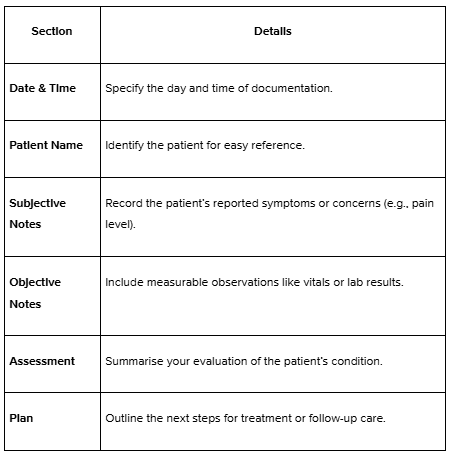
Let’s look at a few real-life scenarios that most mental health practices encounter.
Real-Life Example: A nurse is documenting a patient recovering from surgery:
- Date & Time: January 27, 2025, 9:00 AM
- Patient Name: Emily Brown
- Subjective Notes: Reports mild pain (3/10) in the surgical area.
- Objective Notes: Temperature: 98.6°F, Blood Pressure: 120/80.
- Assessment: Post-op recovery is progressing as expected, with no signs of infection.
- Plan: Continue antibiotics, monitor pain, and encourage mobility exercises.
Another Real-Life Example is a doctor doing rounds in a hospital ward:
- Date: January 27, 2025
- Patient Name: John Smith
- Notes: The Patient remains stable. Appetite has improved. The incision site is healing well.
- Follow-Up Actions: Discharge planning for January 30; confirm physical therapy schedule.
Printable Daily Progress Note
Printable templates are great for consistent documentation for every patient. They are handy in busy clinics or hospitals where quick access to a structured format is essential.
Template Format:
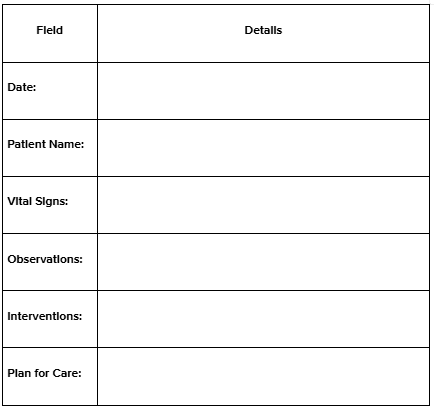
Let’s look at a real-life example of a nurse at a rehabilitation centre tracking a patient's progress.
Real-Life Example: A Mental Health Professional Tracking Progress:
- Date: January 27, 2025
- Patient Name: Sarah Williams
- Mental Health Status: Mood: Stable, Anxiety: Mild (3/10)
- Observations: The patient participated in a 30-minute CBT session, expressing interest in coping strategies.
- Interventions: Provided deep breathing exercises for anxiety management.
- Plan for Care: Focus on coping mechanisms, increase session duration, and schedule follow-up bi-weekly.
How Do These Templates Work?
Templates save time and ensure accuracy, especially in high-pressure healthcare environments. A consistent structure can reduce errors, improve communication, and improve patient care. Whether you prefer a comprehensive or simplified format, these examples give you the tools to document effectively while focusing on what matters most—your patients.
Let’s explore components of daily progress notes in detail, along with their relevant examples.
Components of a Daily Progress Note
Now that you’ve seen examples, let’s break down the essential components of completing a daily progress note. Think of it as a checklist to ensure every detail is captured, making your notes clear, helpful, and professional.
1. Essential Patient Personal and Medical Information
This is your foundation—without the basics, your progress note will lose its value. Start with the patient’s key identifiers and medical details to keep everything organised and traceable.
What to Include:
- Patient’s full name
- Date of birth
- Medical record number
- Admission date (if applicable)
- Primary diagnosis or condition
Example:Let’s say you’re documenting a progress note for a post-op patient:
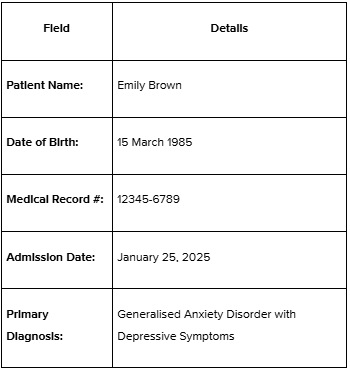
This basic information ensures that your notes are always tied to the correct patient and can be referenced without confusion.
2. Listing of Issues and Updates on Patient's Condition
Here’s where the heart of your daily progress note lies. This section captures the patient’s current status, any updates on their condition, and how issues are being addressed. Be specific and focus on observable changes.
What to Include:
- Symptoms reported by the patient (subjective updates)
- Vital signs or measurable data (objective updates)
- Changes in treatment or response to interventions
- New issues or resolved problems
Example:
For a patient recovering from Mild anxiety:
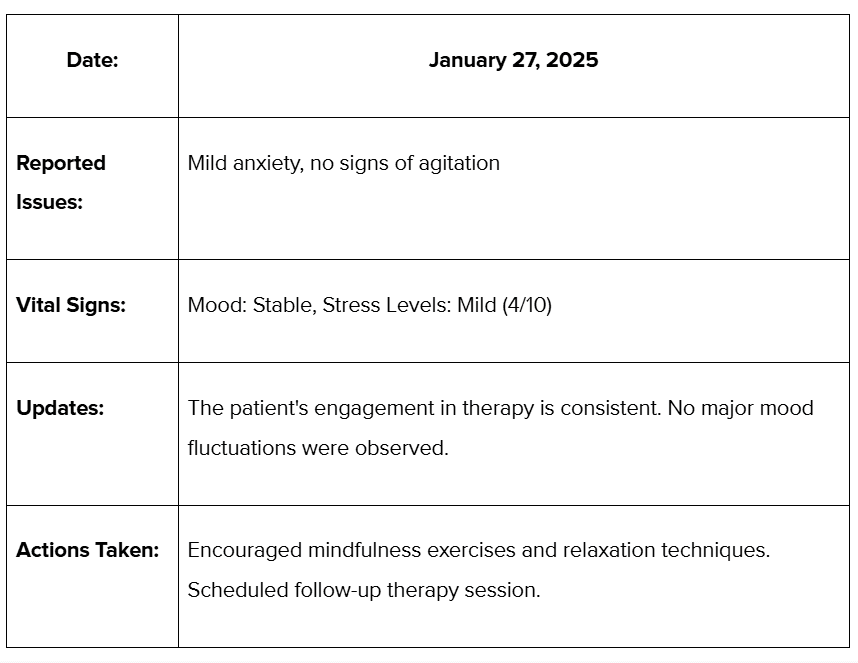
This structure ensures you capture subjective and objective updates, providing a comprehensive view of the patient’s progress.
Pro Tip for Writing Effective Notes
For example, instead of saying, "The patient seems calm," say, "The patient reports feeling less anxious and demonstrates improved coping strategies." Specificity matters, particularly when these notes inform treatment decisions or legal documentation.
By including these essential components, you'll create progress notes that are both professional and valuable tools for your team and your patients.
Now that we have seen different components of daily progress notes, let us explore the steps for writing effective daily progress notes.
Steps to Writing a Daily Progress Note
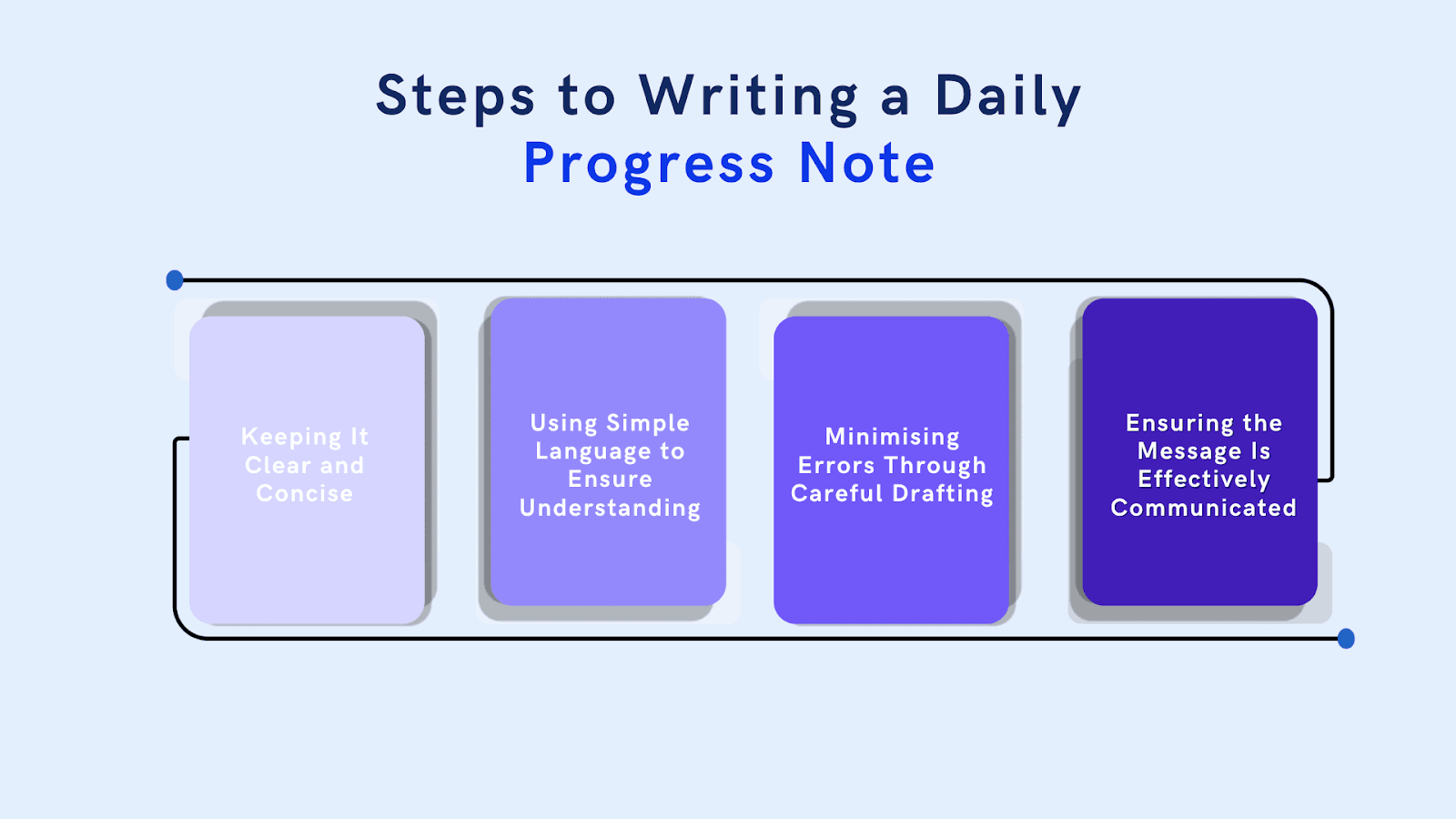
Writing a tremendous daily progress note doesn’t have to feel like a chore. You can create precise, efficient, easy-to-understand notes with simple steps. Let’s break it down into actionable tips to help you get it right every time.
1. Keeping It Clear and Concise
A well-written progress note is like a snapshot—it gives enough detail to paint a complete picture without overwhelming the reader. Focus on the essentials: the patient’s condition, key updates, and the next steps. Avoid overloading the note with unnecessary information.
Example:Rather than writing, "The patient was observed to be in a reasonably good mood today, feeling better overall, and showed a willingness to eat some solid food, which had been an issue earlier," it's more precise to write: "Patient reports feeling better and shared a significant milestone, eating solid food for the first time since admission." This more concise version highlights the key points and presents the information in a way that's easier to understand and more impactful.
2. Using Simple Language to Ensure Understanding
Everyone who reads your notes, from nurses to administrators, must be understood. Avoid medical jargon when possible, and write clearly for all team members.
Real-Life Example:Instead of:"Patient presented with somnolence and mild dyspnea during rounds.”
Write:"Patient appeared drowsy and reported mild difficulty breathing during rounds.”
3. Minimising Errors Through Careful Drafting
Errors in your notes can lead to miscommunication or even compromised patient care. Take an extra minute to review your notes for typos, incomplete sentences, or missing details.
Checklist to Minimise Errors:
- Double-check dates and times.
- Confirm that observations match measurable data (e.g., vitals).
- Ensure that follow-up actions are clearly stated.
Example:Instead of:“Schedule follow-up.”Write:“Schedule follow-up with cardiology for February 2 at 10:00 AM.”
4. Ensuring the Message Is Effectively Communicated
A good progress note doesn’t just report—it informs. Ensure the reader knows what happened, why it matters, and what to do next. Every note should answer these questions:
- What’s the patient’s current status?
- What actions were taken?
- What’s the plan moving forward?
Example Format:
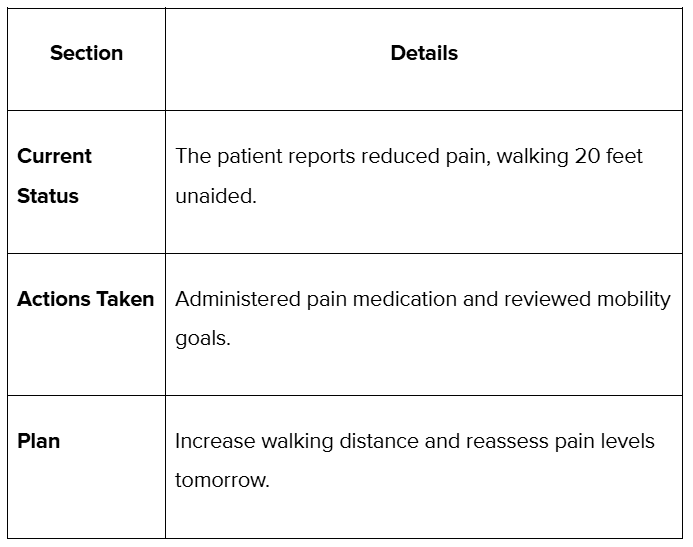
For more information on how to write effective progress notes, check out this YouTube video by Monica Jeong on How to write progress notes efficiently / Tips for doctors and medical students?
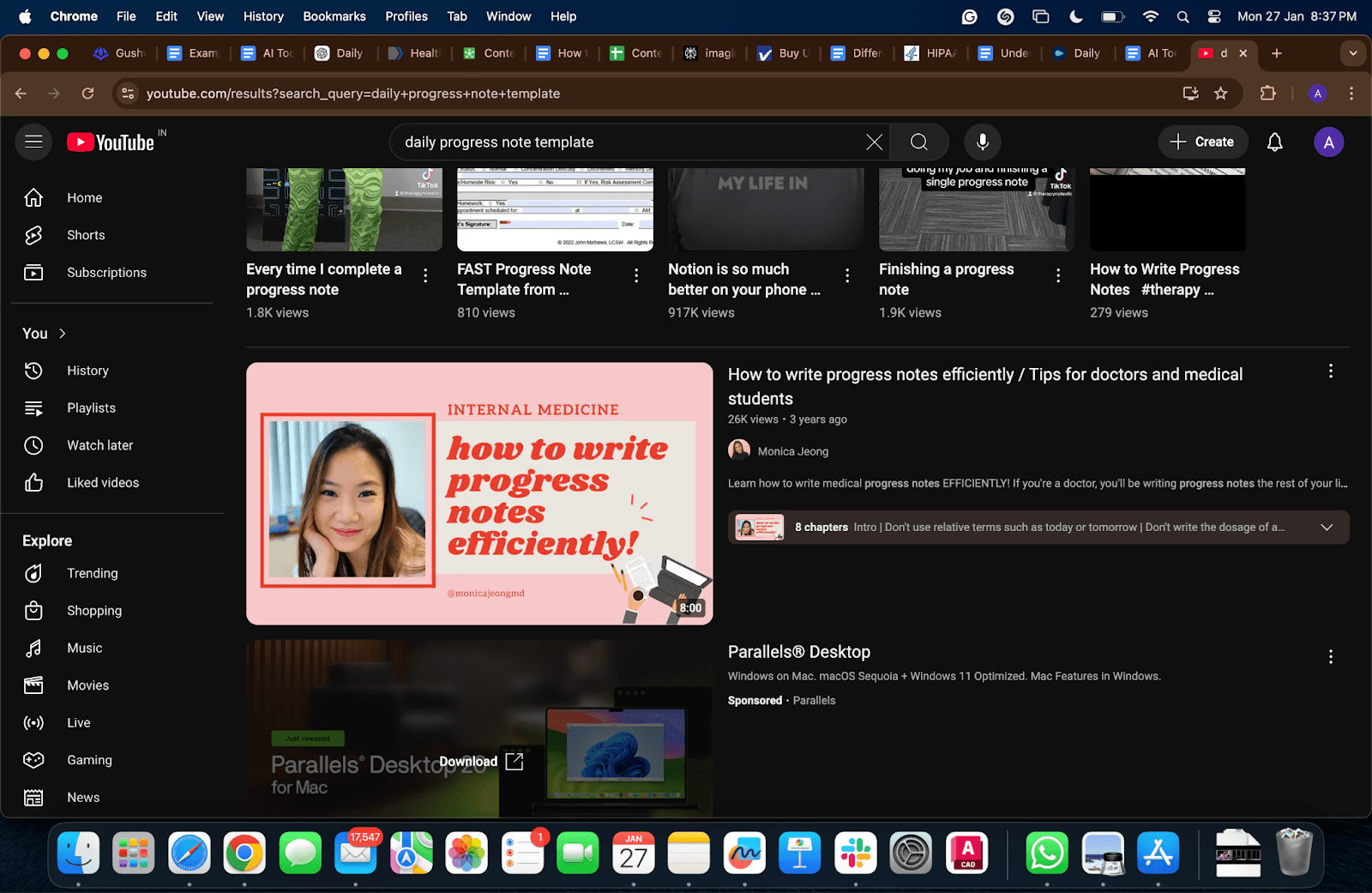
Conclusion
Writing practical daily progress notes doesn’t have to feel overwhelming. By focusing on clear, concise, and actionable documentation, you ensure your notes are valuable tools for communication and decision-making. From including essential patient information to using simple language and minimizing errors, every step contributes to better outcomes—whether in healthcare, education, or any field where progress tracking is critical.
Are you tired of spending hours writing and organizing daily progress notes? Practaluma simplifies the process. Designed for busy professionals, It offers intuitive, customisable templates that help you create clear, professional progress notes in minutes.
With Practaluma, you can:
- Access ready-made templates tailored to healthcare, education, and project management.
- Use innovative autofill features to save time on repetitive fields.
- Ensure accuracy with real-time error-checking tools.
- Store and retrieve notes securely, anytime, anywhere.
Why wait? Streamline your workflow and focus on what truly matters—your work and your clients.
Click below to explore how Practaluma can transform how you document progress: Try Practaluma Today.